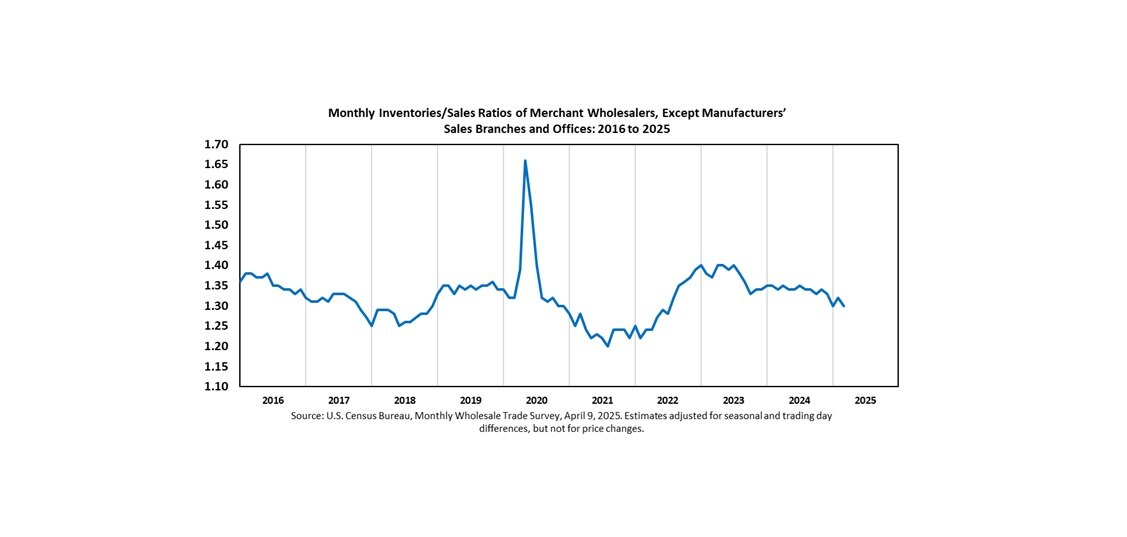Friday, July 09, 2010
Wholesale
This is May's report, and of course it is now July:

This marks the cross and relates to the April sales peak for retail.
Sales rose 0.9 in April, but dropped 0.3 in May. Inventories rose 0.2 in April and 0.5 in May, for a slight increase in the ratio.
I think some retailers have overshot orders, and that there is a mild slowdown in the works. This doesn't mean that any catastrophic event has occurred, just that this is confirmation of the end of the recovery cycle. From here on out, growth in final demand matters.
But other deposits growth is still good. We are also past the end of the lower price cycle on the groceries and moving into the price escalation cycle, which will have a slow impact over the next few months.
Update: See CR's post on hotel occupancy. All of the current indicators show that we have formed a floor and are slowly legging up. It's just that the pace at which the economy can bootstrap itself up is going to be quite slow.

This marks the cross and relates to the April sales peak for retail.
Sales rose 0.9 in April, but dropped 0.3 in May. Inventories rose 0.2 in April and 0.5 in May, for a slight increase in the ratio.
I think some retailers have overshot orders, and that there is a mild slowdown in the works. This doesn't mean that any catastrophic event has occurred, just that this is confirmation of the end of the recovery cycle. From here on out, growth in final demand matters.
But other deposits growth is still good. We are also past the end of the lower price cycle on the groceries and moving into the price escalation cycle, which will have a slow impact over the next few months.
Update: See CR's post on hotel occupancy. All of the current indicators show that we have formed a floor and are slowly legging up. It's just that the pace at which the economy can bootstrap itself up is going to be quite slow.
Comments:
<< Home
John - read the next post. Of course we could get both feet back on the ground, but our spite is choking us.
MoM,
Could "Other Deposits" be a sign of increasing precautionary balances? My theory is that the savings rate decline was a function of the tax credit and transfer payments, and that it will now head back up. The logic is that households are over-levered and illiquid, and that they gave government one chance to kick-start the economy. That chance is gone.
One thing I wonder about is whether the classifications of deposits matter much any more. Money markets, checking CD's -- the difference in rate between all of these is so minimal that only an economist would find it important.
I just don't think a leveraged economy with chronically weak final demand and propped-up asset prices can "sputter" on its way to recovery. Either the inventory build sparks final demand by creating enough jobs, or consumers start saving given the level of insecurity. I share your skepticism over savings rate data, but I'm just looking at direction here, not magnitude.
Post a Comment
Could "Other Deposits" be a sign of increasing precautionary balances? My theory is that the savings rate decline was a function of the tax credit and transfer payments, and that it will now head back up. The logic is that households are over-levered and illiquid, and that they gave government one chance to kick-start the economy. That chance is gone.
One thing I wonder about is whether the classifications of deposits matter much any more. Money markets, checking CD's -- the difference in rate between all of these is so minimal that only an economist would find it important.
I just don't think a leveraged economy with chronically weak final demand and propped-up asset prices can "sputter" on its way to recovery. Either the inventory build sparks final demand by creating enough jobs, or consumers start saving given the level of insecurity. I share your skepticism over savings rate data, but I'm just looking at direction here, not magnitude.
<< Home
 MaxedOutMama
MaxedOutMama


